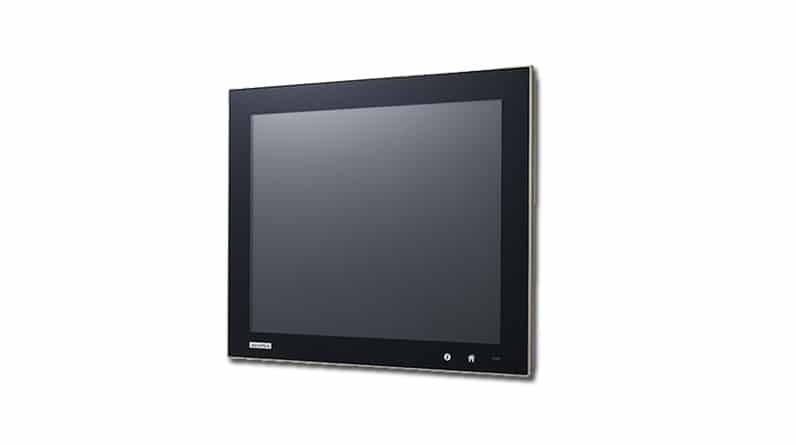3 Reasons to Choose Industrial Monitors vs. Commercial Monitors for Industry 4.0 Applications
3 Reasons to Choose Industrial Monitors vs. Commercial Monitors for Industry 4.0 Applications

In Internet of Things (IoT) and Industry 4.0 applications, more and more customers need to be able to visualize data and processing from embedded machines. Data visualization and process control helps at all levels of the decision-making process, and is best accomplished with human machine interface (HMI).
What is HMI? Generally, it’s used to describe any user interface—such as an LED LCD monitor—that connects users to a machine, device or system. For example, an LED LCD monitor screen allows users to interact with a machine or device in industrial processes. HMI helps bridge the gap between how users connect with process and automation data.
To bridge this gap, a popular option is to implement an LED LCD monitor system where it fits within the factory floor and industry application process. When it comes to LED LCD monitor choices for the factory floor, the first big decision is whether to go with commercial monitors or industrial-grade monitors. When reviewing various monitor prices at face value, it may seem like commercial monitors are the cheaper option, but this is a far-too common mistake.
According to Tim Stone, Advantech IoT Group HMI product manager, it’s an error he’s seen too many customers make, which ends up costing time and money. Why? The simple answer: commercial monitors aren’t designed or built to withstand the rugged usage and environment of Industry 4.0 applications. Specifically, we explore three reasons why the best option is to implement an industrial-grade LED LCD monitor instead of commercial monitor options.
Built for Harsh, Rugged Environments
First and foremost, industrial-grade LED LCD monitors are designed and built for just that: industrial environments, which go hand-in-hand with most Industry 4.0 application environments. Commercial monitors are built for office and retail environments, and they work fine in those environments. They don’t, however, hold up in harsher, industrial environments where they have to content with high vibration, temperature fluctuations, power fluctuations, dirt, dust, a high rate of usage and much more.
For example, the average glass on a commercial tablet touch screen is only rated to last so many uses until it simply doesn’t work anymore. Commercial-grade monitors cannot withstand constant use in industrial environments, says Stone. “People are literally using the monitor all day long, especially if you have a critical application with no down time,” he added. Commercial options simply can’t keep up or withstand industrial elements based on design.
Designed to Meet Industry 4.0 Specifications
In addition to being designed and built for harsh environments with high vibration, temperature fluctuations and more, industrial-grade monitors also can withstand rugged specifications in various industries, such as specific cleaning requirements. Industrial monitors are properly sealed to protect internal components from environmental elements, whether it be dirt, dust, oil or chemicals for cleaning. Many industrial applications, especially those involving food and beverage processes, have cleaning specifications—industrial monitors can meet these requirements based on specific device ratings.
Cost Savings with Consistent Up-Time and Device Logevity
So, what happens when you go with a commercial-grade monitor in an industrial environment? Stone says it’s only a matter of time before that monitor fails. This means the whole process goes into down-time while the monitor is replaced or repaired. “You’re going to replace a commercial monitor at least three times a year,” Stone says, pulling from past customer experiences.
During the monitor replacement, your machine is down and the whole process comes to a halt. Consistency is lost and your workforce is also unproductive. “It all comes down to you asking yourself: what’s the cost of your machine being down?” Implementing an industrial LED LCD monitor help avoid all these costly issues and, frankly, help avoid a lot of grief, he added. Monitors with a rugged, industrial design that are built for harsh conditions must meet far more specifications than commercial devices—you get a quality product with longevity.
Advantech produces a wide range of industrial monitors in various sizes that are equipped to withstand operation in harsh environments. The industrial-grade LED LCD monitors offer a backlight lifetime of 50,000 hours, high IP-rated bezel, wide temperature support, versatile mounting options and are also easy to install for various usage scenarios.

 Industrial Automation
Industrial Automation Edge Computing
Edge Computing Industrial Networking
Industrial Networking Intelligent Connectivity
Intelligent Connectivity HMI’S & Panel Meters
HMI’S & Panel Meters Industrial Rugged Mobile Platform
Industrial Rugged Mobile Platform Cyber Security
Cyber Security Oil & Gas
Oil & Gas Power and Energy
Power and Energy Intelligent Transportation
Intelligent Transportation Smart City & IoT
Smart City & IoT Smart Factory
Smart Factory Industrial Cloud Solution (IIoT)
Industrial Cloud Solution (IIoT) Water And Waste Water
Water And Waste Water Building Management System (BMS)
Building Management System (BMS) Security & Surveillance
Security & Surveillance